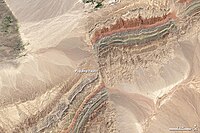
Photo from wikipedia
Scaly fabric was first described early in the development of geology and has experienced a recent renaissance with the realization that it may play a key role in the shallow… Click to show full abstract
Scaly fabric was first described early in the development of geology and has experienced a recent renaissance with the realization that it may play a key role in the shallow coseismic deformation of plate boundary faults, such as the M9 Tohoku-Oki megathrust event. The fabric itself is an anastomosing network of polished surfaces. It is often present in clay-rich sediments deformed by pure and/or simple shear. The faults where it is found typically have multiple modes of slip, from creep to tremor to seismic slip. It is a macroscopic, multi-scale structure that has, to date, been impossible to create under laboratory conditions. In this paper, I review the state of the art of our understanding of this fabric, its mechanical modes of deformation, and its capacity for both aseismic and seismic slip. I also summarize the challenges we face to understand its full importance in the evolution of plate boundary faults. The conclusion is that scaly fabric is linked to frictional-viscous shear zones where bulk viscous deformation is accompanied by localized shear—a condition typical of frictional transition zones in faults.
Journal Title: Geosphere
Year Published: 2019
Link to full text (if available)
Share on Social Media: Sign Up to like & get
recommendations!